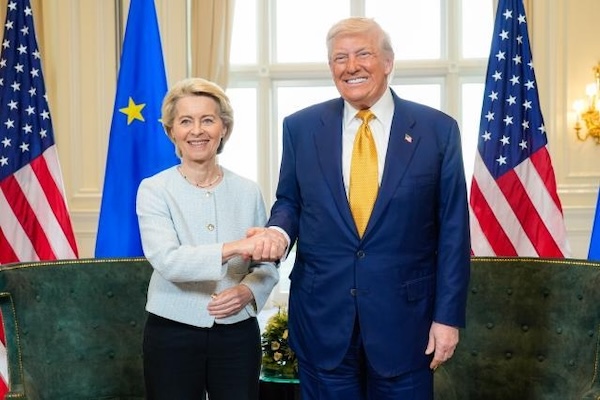.png)
With US–EU Deal Done, Spotlight Shifts to New Delhi
Recent trade deals of the US share a clear structure: Washington imposes new tariffs, ranging from 10% to 20% above MFN rates, while securing near-complete tariff elimination from its partners.


By Ajay Srivastava
Ajay Srivastava, founder of Global Trade Research Initiative, is an ex-Indian Trade Service officer with expertise in WTO and FTA negotiations.
July 28, 2025 at 10:32 AM IST
The United States and the European Union finalised a sweeping trade framework on July 27, 2025, during a meeting at President Donald Trump’s Turnberry golf resort in Scotland.
Under the deal, the US scaled back its threatened 30% blanket tariff on EU imports, settling on a 15% levy applied to most goods, including semiconductors, automobiles, and pharmaceuticals. However, aircraft and parts, certain chemicals, generic drugs, and some agricultural products from the EU will remain exempt. Steel and aluminum, however, will continue to face a 50% US tariff. These tariffs are over and above existing MFN levels.
In return, the EU agreed to eliminate tariffs on a broad list of US exports, ranging from aircraft and semiconductor tools to agricultural goods and raw materials.
Brussels also committed to easing product standards and certification rules that have long hindered US automobile and farm exports.
More significantly, the EU pledged to invest $600 billion in the US over three years and committed to importing $750 billion in US energy, including LNG, oil, and nuclear fuel. It also promised “hundreds of billions” in purchases of US defense equipment.
While the deal averts an immediate trade war, critics in Europe warned that such deep concessions could weaken the EU’s own industrial competitiveness.
The Pattern
The EU deal marks the fifth in a rapid series of trade agreements concluded by the Trump administration, following earlier pacts with the United Kingdom, Vietnam, Indonesia, and Japan.
These agreements share a clear structure: Washington imposes new tariffs, ranging from 10% to 20% above MFN rates, while securing near-complete tariff elimination from its partners. UK goods now face a 10% tariff, EU and Japanese products 15%, Indonesian goods 19%, and Vietnamese exports 20%.
These deals also feature large-scale investment pledges and committed purchases. Japan has committed to invest $550 billion in the US, while the EU has pledged $750 billion, with a major focus on energy, infrastructure, and manufacturing. Partner countries have also agreed to buy substantial volumes of US oil, gas, and arms, boosting American industries. Additionally, several partners have promised to ease non-tariff barriers, particularly for U.S. automobiles and agricultural products.
India-US deal?
With the August 1 deadline for finalising new trade deals nearing, the White House may aim to secure one more big agreement, this time with India. If agreed, the US–India deal could follow the same pattern as recent ones, with around 15% tariffs on Indian exports to the US, in return for tariff cuts, investment pledges, and regulatory access for American firms.
A deal with the US, India’s largest trading partner, would be a major economic and strategic step for New Delhi. But India must be careful not to give in to unbalanced or excessive US demands.



